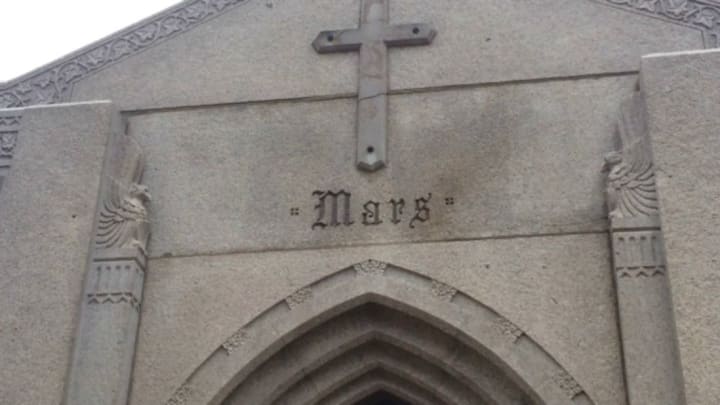Every time we so much as touch a toe out of state, I’ve put cemeteries on our travel itinerary. From garden-like expanses to overgrown boot hills, whether they’re the final resting places of the well-known but not that important or the important but not that well-known, I love them all. After realizing that there are a lot of taphophiles out there, I’m finally putting my archive of interesting tombstones to good use.
Do you like M&Ms? Indulge in the occasional Milky Way? Satisfy your hunger with a Snickers? Appreciating any of those sweet treats is an appropriate way to pay your respects to Frank and Forrest Mars, pioneers of one of the world's largest candy brands.
Frank Mars—born in Hancock, Minnesota, in 1882—contracted polio at a young age. Confined to a wheelchair, the young Mars spent a lot of time in the house with his mother, Alva, who taught him how to hand dip chocolate.
After he graduated high school, Mars decided to become a candy wholesaler. He married Ethel Kissack, and they had a son, Forrest, in 1904. Unfortunately, familial bliss wouldn’t last long. Mars and Ethel divorced, and Forrest was sent to live with Ethel’s parents in Saskatchewan, Canada.
Meanwhile, Frank kept plugging along at the candy business. After a string of serious setbacks, including bankruptcy and failed businesses in Seattle and Tacoma, he had finally found local success with the Mar-O-Bar, a confection made with caramel, nuts, and chocolate.

Stacy Conradt
The business was struggling along until Frank reunited with his son in 1923. Forrest had gone to college and was working as a traveling salesman, and that summer, he and a crew of men were working in the Chicago area, putting up posters for Camel cigarettes. Forrest managed to get arrested for plastering the advertisements over municipal signs and he called his father for bail.
It was the beginning of a profitable, if tumultuous, relationship. Forrest later recalled that he and his father were enjoying a snack at a soda fountain and discussing the business when he looked down at his ice cream drink. “Why don’t you put this chocolate malted drink in a candy bar?” he suggested. Within weeks, Frank came up with a bar centered around chocolate malt nougat, the Milky Way. “He put some caramel on top of it, and some chocolate around it - not very good chocolate, he was buying cheap chocolate - but that damn thing sold. No advertising,” Forrest said in a rare (exceedingly rare—the Mars family is notoriously private) interview.
It was a resounding success, which only led to arguments on how to run the business. Eventually, Forrest told Frank to “Stick the business up his ass. If he didn't want to give me one third right then, I said I'm leaving. He said leave, so I left.” He went to England and started his own branch of the business there, establishing the hugely popular Mars Bars and getting the inspiration for M&Ms, which he would eventually take back to the States.
Frank died suddenly in 1934, the victim of kidney failure. Forrest did not return home to attend the funeral. Frank was originally buried at Milky Way Farms, the family farm in Tennessee. His widow later had Frank and the mausoleum moved to Chicago, and finally to Lakewood Cemetery in Minneapolis.
There were many more ups and downs and family disagreements, but Forrest later became chairman of Mars, Inc., in 1959, and merged his company—Food Manufacturers, Inc., home to products like Uncle Ben’s Rice—in 1964.
The father-and-son reunion that didn’t happen during Frank and Forrest’s lifetimes eventually happened in death. When Forrest’s wife, Audrey, died in 1989, he had her interred at the family mauseoleum in Minneapolis. He joined her there in 1999 when he passed away at the age of 95.
Peruse all the entries in our Grave Sightings series here.
